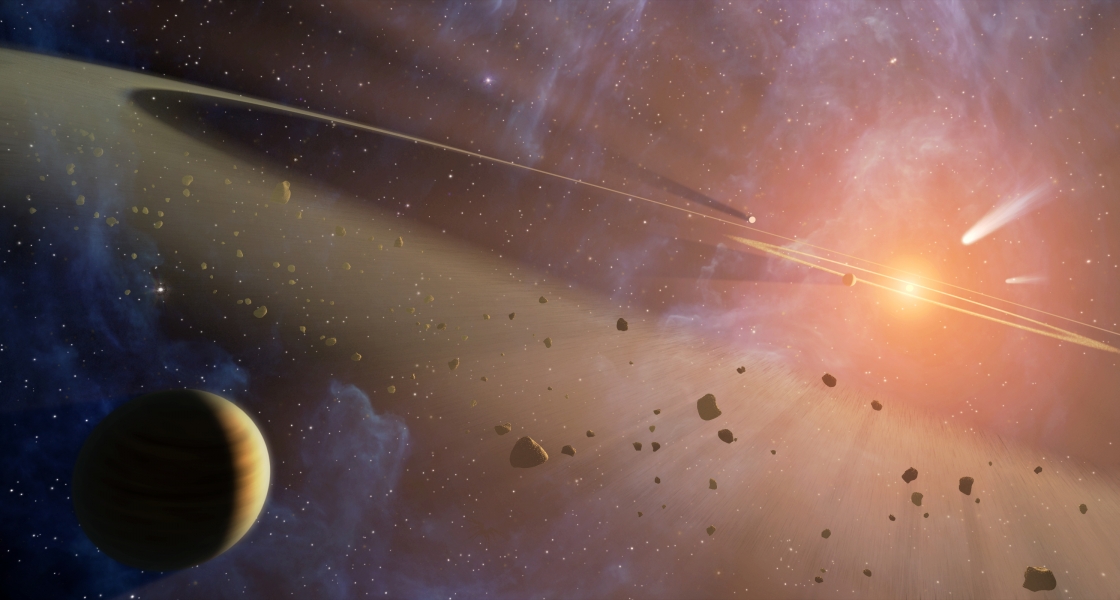Fellow Phil Armitage and group collaborator Jacob Simon of the Southwest Research Institute are leading work to answer a central question about planet formation: How do pea- and pebble-sized objects orbiting within a protoplanetary disk evolve into asteroid-sized objects tens to hundreds of kilometers in size? This is an important question to answer because the eventual formation of planets around a star is mainly governed by the gravitational interactions of these primordial asteroids.
The formation of primordial asteroids is likely initiated by the gravity. When you have pebbles in a protoplanetary disk, under the right circumstances, the pebbles cluster into very dense clumps, which collapse into primordial asteroids, or planetesimals.
Armitage prefers to call them planetesimals because the word asteroid conjures up the Solar System’s asteroid belt, which is filled with asteroids of all sizes, many of which were likely produced in violent collisions. In other words, most of the asteroids in the asteroid belt are too small (and new) to be considered planetesimals.
However, planetesimals may well exist in the Solar System. The Solar System’s outermost region, known as the Kuiper belt, is sparsely populated and far from the Sun. This region has changed little since the Solar System formed. Planetesimals have survived there for billions of years. Because they are so far apart, they almost never collide. Curiously, many Kuiper-belt objects exist as pairs orbiting one another.
The Kuiper belt may offer insights into the creation of the building blocks of the eight major planets. Collisions between planetesimals are thought to have produced the rocky planets (Mercury, Venus, Earth, & Mars) and the cores of the giant planets (Jupiter, Saturn, Neptune & Uranus).
Since the growth of planetesimals is central to the formation of planets, Armitage and Simon have been working on theoretically modeling this process with the help of National Science Foundation (NSF) supercomputers. In their modeling, the researchers are focusing on how pebble-sized objects clump together to form planetesimals of a wide range of sizes, from a few kilometers up to hundreds of kilometers.
A central focus of this work is the basic process known as the streaming instability. The streaming instability occurs because pebbles orbit faster than the gas around a star. As the pebbles and gas try to move through each other, the pebbles start clumping together.
“One analogy for this process is the formation of a peloton in the Tour de France,” Armitage explained. “If you have a bunch of cyclists, and they’re cycling against the wind, then they do better if they clump together in a group rather than staying spread out. So there can be an energetic advantage to being close together and clumped up. We think this behavior may be somewhat related to what happens to the pebbles.” Armitage cautioned, however, that streaming instability isn’t exactly the same thing as what happens to bicycle racers, but serves as an illustrative analogy.
Armitage and Simon plan to continue to probe what happens as clumps of pebbles collapse down to form denser planetesimals. They’re particularly interested in learning how to accurately model the process in a real protoplanetary disk where the density of gas and solid material is quite low.
The researchers involved in this continuing quest to understand the formation of planetesimals include Rixin Li and former JILA Senior Research Associate Andrew Youdin, both of the University of Arizona, JILA group collaborator Jacob Simon of the Southwest Research Institute, and Fellow Phil Armitage.––Julie Phillips



 The Physics Frontiers Centers (PFC) program supports university-based centers and institutes where the collective efforts of a larger group of individuals can enable transformational advances in the most promising research areas. The program is designed to foster major breakthroughs at the intellectual frontiers of physics by providing needed resources such as combinations of talents, skills, disciplines, and/or specialized infrastructure, not usually available to individual investigators or small groups, in an environment in which the collective efforts of the larger group can be shown to be seminal to promoting significant progress in the science and the education of students. PFCs also include creative, substantive activities aimed at enhancing education, broadening participation of traditionally underrepresented groups, and outreach to the scientific community and general public.
The Physics Frontiers Centers (PFC) program supports university-based centers and institutes where the collective efforts of a larger group of individuals can enable transformational advances in the most promising research areas. The program is designed to foster major breakthroughs at the intellectual frontiers of physics by providing needed resources such as combinations of talents, skills, disciplines, and/or specialized infrastructure, not usually available to individual investigators or small groups, in an environment in which the collective efforts of the larger group can be shown to be seminal to promoting significant progress in the science and the education of students. PFCs also include creative, substantive activities aimed at enhancing education, broadening participation of traditionally underrepresented groups, and outreach to the scientific community and general public.